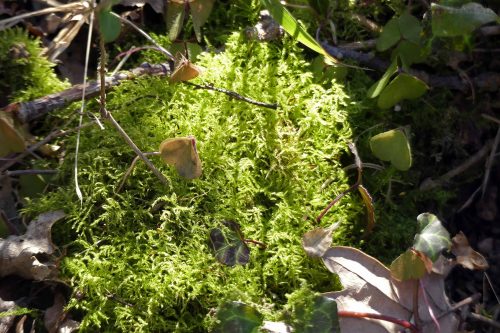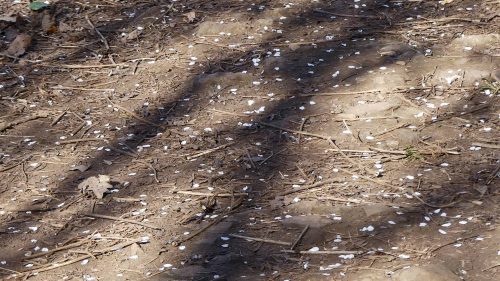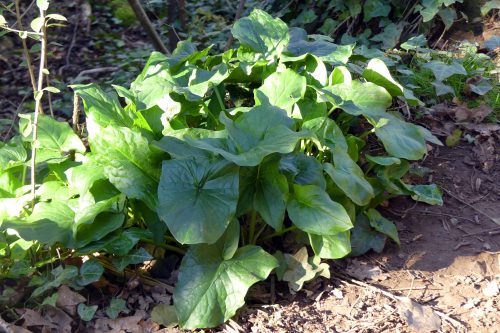Tags
Bryn Euryn Nature Reserve, cherry plum, coal tit, flowering in February, garden escapes, hazel catkins, non-native plants, Nuthatch
Enjoying the sunshine of this glorious morning, a bright-eyed Dunnock sat on a platform of leaves of the Laurel hedge preening and soaking up the warmth. 
Woodland Path
The sight of the sunbathing Dunnock sparked the idea of a theme for this morning’s walk, or rather the Laurel did. Bryn Euryn is almost an island, virtually surrounded by houses and running the length of the side I often begin my walks, is the busy A55 North Wales Expressway. Its summit was once the site of an ancient Hill Fort, where a Trig Point now stands. There are ruins of an old manor house and exposed rock cliffs around a field next to the car park mark the site of an old quarry. Opposite the car park there’s a large area of land given over to allotments. This long-reaching proximity of people and the plantings in their gardens, has inevitably led to the presence of trees, shrubs and flowers that wouldn’t be there naturally. Today I thought I’d make a point of looking out for some of the more obvious ones amongst the natives.
There’s quite a lot of Laurel growing in this particular spot on Bryn Euryn, doubtless planted when a grand house occupied the site now replaced with our small development of flats. This is Cherry Laurel, introduced from south-east Europe in 1547 and quickly popularised for creating ornamental hedges. Apart from the Rhododendron, it is the most common introduced evergreen in Britain. It’s beginning to flower here now: the flowerheads stand erect like candles and are made up of small creamy-white flowers that smell a bit like marzipan.
Twining into the Laurel, reaching across the path is Honeysuckle, which is a true native; its leaves already almost fully grown.
On the edge of the track and scrambling up the woodland slope deep blue Greater Periwinkle is flowering. Evergreen under-shrubs native to Europe, north-west Africa and southern Asia, this would most likely have been planted here originally, but the Periwinkles are long enough established and widespread in the wild to be included in wildflower books, often listed as garden escapes.
A Song Thrush was singing its energetic and joyous song rising up from somewhere on the steep slope below. eating Ivy berries, A Great Tit called out its signature ‘teacher-teacher’, loud and clear. Blue Tits were all around me, calling to one another as they flitted about investigating shrubs and trees in their endless quest to find food. I caught a glimpse of one above my head; it was pure luck that I caught one holding a twig in its claw while it pecked at a leaf bud. The marks above its head are insects, not specks on my lens!
Blackbirds were rustling around in thick Ivy, grabbing berries. 
Another shrubby archway reaches over the path formed by more Laurel and Berberis, which is just beginning to flower. Berberis, or Barberry, is another shrub familiar in gardens. I also spotted a few small Mahonia plants along the way, all bearing flowers.
On a Polypody fern frond sat a bright shiny new hoverfly, gleaming bronze in the bright light. Two Greenbottle flies chose an Ivy leaf to sunbathe upon.
Towering over the greenery, bare trees, their branches silvery against the intensely blue sky, remind that there is still a while to go before the true Spring arrives.
 Grey Squirrels have been active throughout this mild winter; there have been very few days when I haven’t seen at least one from my windows. I’m not a fan of this introduced species because of their dominance over our native Reds and the tremendous amount of damage they do to our woodland trees. I have to remind myself they have no natural enemies, it’s not their fault they’re here and they’re just trying to stay alive; how are they supposed to know better?
Grey Squirrels have been active throughout this mild winter; there have been very few days when I haven’t seen at least one from my windows. I’m not a fan of this introduced species because of their dominance over our native Reds and the tremendous amount of damage they do to our woodland trees. I have to remind myself they have no natural enemies, it’s not their fault they’re here and they’re just trying to stay alive; how are they supposed to know better?
Like most people, I’m sure, I barely go a day without seeing a Wood Pigeon which are common and numerous just about everywhere in Great Britain. They’re another species that have taken full advantage of what we put out on offer and their populations seem to have benefitted from changes in farming practices. They are generally considered as pests by farmers, gardeners and gamekeepers as they’ll eat grains and greens, especially newly sprouting ones, all day long. I rather like them, most of the time they seem very laid-back and have that beautiful soft grey and pinky-purple plumage and the white neck patch; it is nice to see them actually in the woods.
In one spot up near the top of this Woodland Path there’s a well-established Gooseberry bush, with a few smaller ones dotted around nearby on both sides of the track. More familiar in gardens and allotments, Gooseberry is frequently found in the wild, growing in woods, in scrub and in hedges and are probably mostly bird-sown.
Stopping to photograph the Gooseberry I heard a Wren singing. It was close to me but I couldn’t spot it. There are a few Celandines flowering, but they’re quite sparse, perhaps because it’s been so dry.
A native wild flower, Dog’s Mercury is flowering. It’s still short, not yet more than six inches (7.5cm) tall.
Here and there are clumps of pretty ferny moss. This one is in the middle of the Wood Sorrel patch, whose shamrock-shaped leaves are just beginning to unfurl.

Spurge Laurel is one of the more unusual plants that grows here on the Bryn. It is a native plant that favours wooded chalky hillsides, so I have no reason to think it’s not here naturally, but I haven’t seen it on any other sides of the hill. A very small shrub that must contend with much taller trees and shrubs towering over it, it’s equipped with thick leathery evergreen leaves, resembling those of Laurel, that can withstand dripping rainwater. It produces its small green fragrant flowers early in the year to make the most of the light before a new canopy of leaves shuts it out.
The near hills and more distant mountains were veiled by a misty haze. Patches of snow clung to the highest peaks, another reminder that winter is still not past. As I stood looking at the view I heard a Woodpecker drumming back in the direction I’d just walked.

Alexanders puts out it new leaves early, often in early February and it’s quite well grown now. It has established on the path-side just before it reaches the reserve and although woodland is not it’s usual habitat, it seems to be spreading. Another introduced plant, Alexanders was brought in as a food plant by the Romans; it has a mild, celery-like taste. This a plant that isn’t usually found far from the sea; there’s a lot of it locally on the Little Orme and in recent years it has spread prolifically along the verge of Llandudno Road, which I suppose is not that far away as birds fly.
The Woodland Trail
Where the Woodland Path meets the Woodland Trail of the Nature Reserve, a Flowering Currant bush is in bloom.

Flowering Currant – Ribes sanguineum
A popular and familiar garden shrub, with pungently aromatic leaves,this one was again probably also bird-sown. As with the Gooseberry, Flowering Currant can be found throughout the British Isles naturalised in woods, scrub and on waysides.
The Trail is dry and baked hard. The unseasonal warm sunny weather is a treat, but we’re going to need some rain soon. Gorse is flowering more strongly now. I can never resist a chance to smell the warm coconut aroma of its golden flowers. Delicious.
As I reached the enormous bramble patch a Long-tailed Tit flew across the trail in front of me. It disappeared into the dense shrubbery, but then I saw another in the bramble patch. I could see it through the tangle of stems but not clearly enough to photograph. I waited for a few minutes hoping for a better view, but no luck. About to walk on I heard a whistling call and watched a bird fly strongly over the track and land high in a Sycamore tree. It was clearly on the move, so I took a ‘panic pic’ in case I missed it, but just managed to catch it before it zoomed off; a Nuthatch. I was thrilled, I’ve had very sparse sightings of them here, and never this high up in the woods.
Yew trees are our third native conifer tree, after Scots Pine and Juniper. They are widespread throughout these woods, where they grow well on the chalky hillside. A number of them line a section of the Trail, with other single trees on the other side.
One in particular was heavily laden with flowers. Yews are one of those species that have separate male and female trees. This one is a male; the female flowers are less conspicuous, being tiny and green.
Then there’s a line of Ash saplings, they are growing so closely together they almost make a living fence. More ‘invaders’ grow along the edge of this stretch of the Trail; Tutsan and the dreaded Cotoneaster, which has thus far escaped being routed out. 
Beyond the Ash are the Hazels. From the way in which they grow it would seem that at some time in their history they were pollarded as now most of the trees are multi-stemmed and form a small thicket. They are all quite tall though, so if ever they were cut it must have been some time ago.
Because the trees are tall and growing on a steep slope, you perhaps don’t get the full effect of their crop of pale golden yellow catkins, you have to look up. 
There were more Blue Tits here exploring the Hazels and the surrounding vegetation. At the beginning of this month, on an equally blue-skied sunny day I’d stopped here to look for the female flowers of the tree, which are tiny and red and quite hard to spot, especially if you need reading glasses, as I do, but can’t be bothered to keep putting them on to look for things when out walking.
This was not the best place to look as even the lower branches are above my head, so the photograph above is one I made earlier. Once again though, my hanging around brought a reward. Often a good spot for catching sight of parties of Tits, I was lucky enough to see a pair of Coal Tits arrive and spend a few minutes foraging through the trees. I loved the way they grasped individual Catkins, inspecting them closely to check for hiding insects.
A bit further along the Trail and on the other side from the Hazels, a tree smothered with frothy white blossom shown up perfectly by the deep blue sky; a proper floral treat.
This is a Cherry Plum, although not the truly native wild one as it has bronzy-coloured leaves and not the plain green of the wild one. It could be Prunus atropurpurea, which is a popular garden tree, but I’m not sure.
I don’t think its exact pedigree matters too much, it was lovely to look at and more importantly was also attracting the attentions of quite a few insects. All very high up though. There were definitely a couple of smallish bees and small long hoverflies.
The blossom won’t last for long; already petals are falling and strewing the ground below like confetti.

Another good reason to take one last photograph with the sun shining through it.
Back at ground level, the leaves of Lords and Ladies, or Cuckoo Pint if you prefer, are well grown now, they began to appear back in late January.
and to finish, a first sighting this year of a single Dog Violet.
Birds today: Wood Pigeon; Carrion Crow; Raven; Magpie; Herring Gull; Nuthatch; Blackbird; Robin; Dunnock; Great Tit; Blue Tit; Long-tailed Tit Heard: Song Thrush; Wren; Gt Spotted Woodpecker (drumming)




























Thank you Neil, it is an interesting plant that has a number of folklore/legends attached to it which I’ll be covering in a post coming soon…. You take care too, best wishes, Theresa
LikeLike
Wow. Learnt so much from this post. Thanks!
LikeLiked by 1 person
Thank you kindly, Paul, glad you found it useful!
LikeLike
Lovely post and lots of wild flower info. Thanks. X
LikeLiked by 1 person
Thank you Shazza, I love this time of year when the wildflowers begin to venture out again. Hope they survive Storm Freya!
LikeLike
Wonderful and I also loved your Ashphodel post. Read it in the morning and then walked to Alcoutim fort and saw them all.
LikeLiked by 1 person
Thank you on both counts. I envy you your walk!
LikeLiked by 1 person
It was warm and sunny!
LikeLiked by 1 person
The cuckoo pint looks like a plant in my garden. Thanks for identifying it!
LikeLiked by 1 person
You’re welcome! You’ll know for sure if and when it produces its distinctive flower & spathe.
LikeLike
Excellent walk!
Hadn’t heard of Spurge Laurel before. A beautiful plant. Take care.
Neil Scheinin
LikeLiked by 1 person